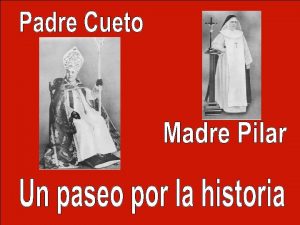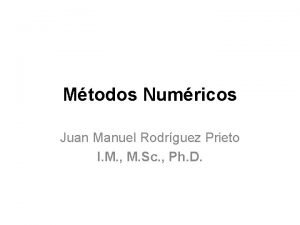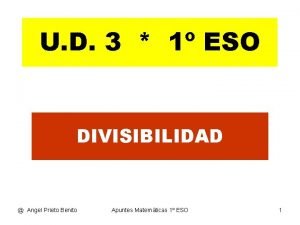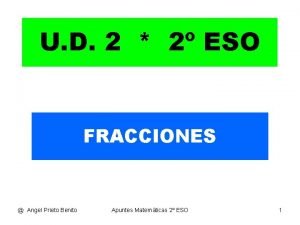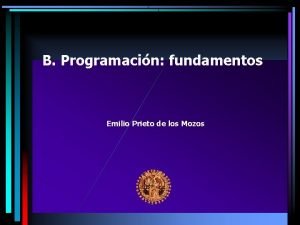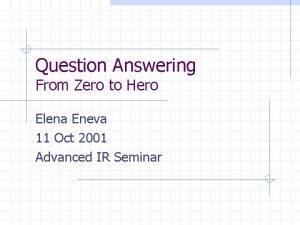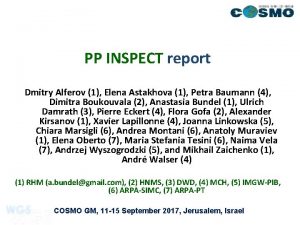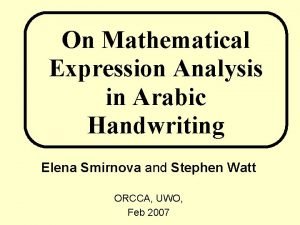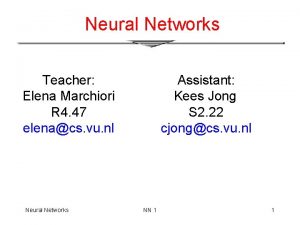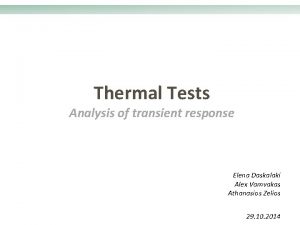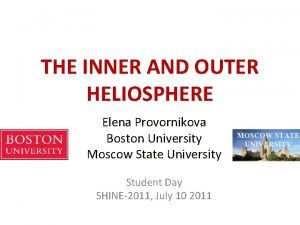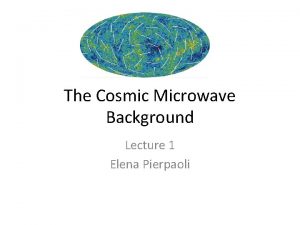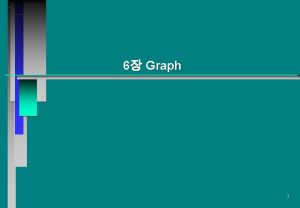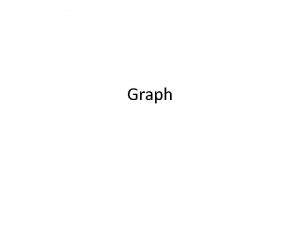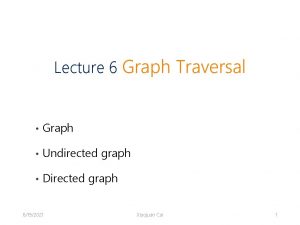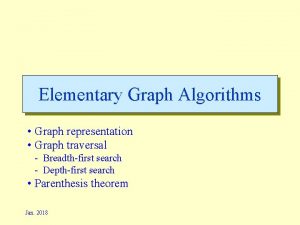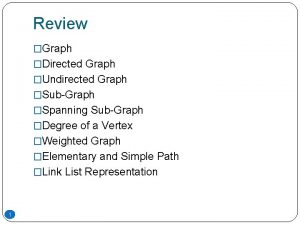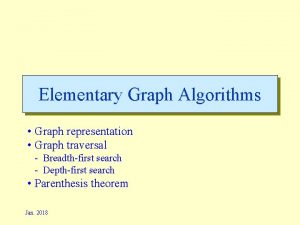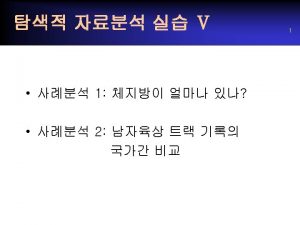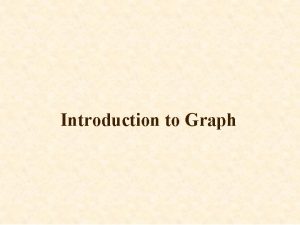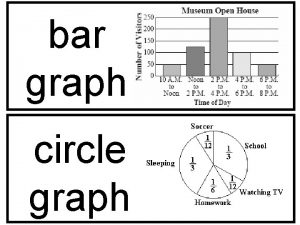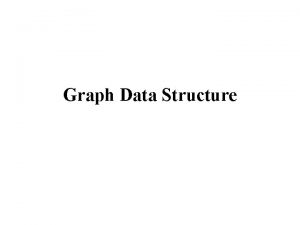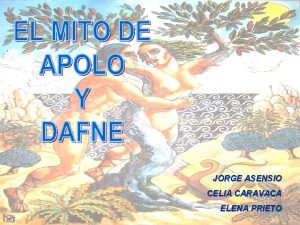GRAPH THEORYNETWORKS Dr Elena Prieto Lecturer School of






























































- Slides: 62

GRAPH THEORYNETWORKS Dr Elena Prieto Lecturer School of Education Faculty of Education and Arts

PRESENTATION CONTENTS § Graphs, vertices and edges § Adjacency matrices § Complete graphs § Subgraphs § Connectedness § Cycles § Depth first search 2

“RECOGNISE CIRCUMSTANCES IN WHICH NETWORKS COULD BE USED” Often mathematicians are involved with many different problems that need to be solved. Some examples of these sort of problems are: A company that repairs TV aerials owns 3 vans, that go to customer’s houses 9 am – 4 pm every week day. The aerial repair jobs are in different suburbs all over Newcastle. Which vans should go to which jobs to minimise travel time and maximise time spent working? A company has a website for booking flights to go all around the world, from a variety of different airlines. Customers can search for flights by price and number of flights. How does the company ensure that the search results are the cheapest and quickest available? A new hospital is being built, that has many departments that need to report to other certain departments frequently. What is the ideal layout of the building to maximise communication between departments that need to report to each other all the time? 3

“IDENTIFY AND USE NETWORK TERMINOLOGY” Graph Theory is an area of Mathematics using structures called Graphs have Vertices (plural of Vertex) Edges that connect them Graphs can be weighted - Edges have weights, such as a distance or cost Used for problem solving, because they can be used to represent many different problems 4

“SOLVE PROBLEMS INVOLVING NETWORK DIAGRAMS” You have a visitor from overseas staying with you for a day who wants to visit all of the parks in Newcastle’s city. How do you maximise time spent at the parks, and minimise travel time? 5

“SOLVE PROBLEMS INVOLVING NETWORK DIAGRAMS” 6

“GIVEN A MAP, DRAW A NETWORK” by’s Nob ach Be rve e Res Cathedral Park The Foresho re Newcastl e Baths Nesca Park King Edward Park 7

“GIVEN A MAP, DRAW A NETWORK” 6 3 4 5 2 1 8

“GIVEN A MAP, DRAW A NETWORK” 6 3 4 2 5 1 9

“GIVEN A MAP, DRAW A NETWORK” 6 3 4 2 5 1 V: ={1, 2, 3, 4, 5, 6} E: ={{1, 2}, {1, 5}, {2, 3}, {2, 5}, {3, 4}, {4, 5}, {4, 6}}

“DEGREE OF A VERTEX, DIRECTED NETWORKS AND WEIGHTED EDGES” 6 3 4 2 5 1 Degree of a vertex is the number of edges adjacent to it

“DEGREE OF A VERTEX, DIRECTED NETWORKS AND WEIGHTED EDGES” 6 3 4 2 5 1 If the edges have a direction (like one-way streets) we say the network is ‘directed’

“DEGREE OF A VERTEX, DIRECTED NETWORKS AND WEIGHTED EDGES” 4 6 3 8 2 4 6 4 2 5 5 1 3 We can also add weights (indicating distance, time or…) to the network

“DEGREE OF A VERTEX, DIRECTED NETWORKS AND WEIGHTED EDGES” 4 6 3 8 2 4 6 4 2 5 1 Worksheet 5 1 3 We can also add weights (indicating distance, time or…) to the network

BUT WE WILL NEED MORE! Adjacency matrices Complete graphs Subgraphs Connectedness Cycles Depth first search

ADJACENCY MATRIX 6 3 4 2 5 1 The adjacency matrix of a graph is a matrix whose rows and columns are both indexed by vertices of the graph, with a one in the cell for row i and column j when vertices i and j are adjacent, and a zero otherwise.

ADJACENCY MATRIX 6 3 4 1 2 2 5 1 0 1 1 2 3 4 5 6 0 0 1 0 1 0 0 0 1 1 0 0 0

ADJACENCY MATRIX 6 3 4 2 5 0 1 1 0 0 1 0 0 1 0 1 0 0 0 1 0 0

ADJACENCY MATRIX 6 3 4 2 5 0 1 1 NOTE A: The matrix is symmetric with respect to the main diagonal NOTE B: What would you do if we had a weighted graph? 0 0 1 0 1 0 0 1 0 1 0 1 0 0

COMPLETE GRAPHS 6 3 4 2 5 1 A complete graph is a graph in which every two vertices are adjacent: all edges that could exist are present.

COMPLETE GRAPHS 6 3 4 2 5 1 A complete graph is a graph in which every two vertices are adjacent: all edges that could exist are present.

COMPLETE GRAPHS Worksheet 2 A complete graph is a graph in which every two vertices are adjacent: all edges that could exist are present.

SUBGRAPHS 3 2 4 6 5 1 A subgraph is a subset of the vertices and edges

SUBGRAPHS 3 2 5 1 V: ={1, 3, 4, 5} E: ={{1, 5}, {3, 4}} 4 6

CONNECTEDNESS 6 3 4 2 5 1 A graph is connected if any two vertices can be joined by a path of edges

CONNECTEDNESS 6 3 4 2 5 1 The subgraph in the previous example is NOT connected because we cannot connect (for example) 3 and 5.

CONNECTEDNESS 3 4 5 1 The subgraph in the previous example is NOT connected because we cannot connect (for example) 3 and 5.

CYCLES 3 2 4 6 5 1 A cycle is an alternating sequence of vertices and edges, starting and ending at the same vertex, in which each edge is adjacent in the sequence to its two

CYCLES 3 2 4 6 5 1 A cycle is an alternating sequence of vertices and edges, starting and ending at the same vertex, in which each edge is adjacent in the sequence to its two

DEPTH-FIRST SEARCH Depth-first search (DFS) is an algorithm for traversing or searching graph data structures. One starts selecting some arbitrary node as ‘the root’ and explores as far as possible along each branch before backtracking.

DEPTH-FIRST SEARCH (CONNECTEDNESS) set visited to empty list set to visit to empty stack push node 1 to to visit while (to visit is not empty) { set current node to the top item of to visit pop the top item from to visit if (visited does not contain current node) { add current node to visited 3 2 1 4 5 6 for each (neighbour) of (neighbours of current node) { if visited does not contain (neighbour) { push neighbour to to visit } } } return (length of visited is equal to the number of nodes)

DEPTH-FIRST SEARCH (CONNECTEDNESS) set visited to empty list set to visit to empty stack push node 1 to to visit while (to visit is not empty) { set current node to the top item of to visit pop the top item from to visit if (visited does not contain current node) { add current node to visited for each (neighbour) of (neighbours of current node) { if visited does not contain (neighbour) { push neighbour to to visit } } } return (length of visited is equal to the number of nodes) 3 2 1 4 5 6 visited {} List to visit Stack

DEPTH-FIRST SEARCH (CONNECTEDNESS) set visited to empty list set to visit to empty stack push node 1 to to visit while (to visit is not empty) { set current node to the top item of to visit pop the top item from to visit if (visited does not contain current node) { add current node to visited for each (neighbour) of (neighbours of current node) { if visited does not contain (neighbour) { push neighbour to to visit } } } return (length of visited is equal to the number of nodes) 3 2 1 4 5 6 visited {} to visit 1

DEPTH-FIRST SEARCH (CONNECTEDNESS) set visited to empty list set to visit to empty stack push node 1 to to visit while (to visit is not empty) { set current node to the top item of to visit pop the top item from to visit if (visited does not contain current node) { add current node to visited for each (neighbour) of (neighbours of current node) { if visited does not contain (neighbour) { push neighbour to to visit } } } return (length of visited is equal to the number of nodes) 3 2 1 4 5 6 visited {} Current node to visit 1

DEPTH-FIRST SEARCH (CONNECTEDNESS) set visited to empty list set to visit to empty stack push node 1 to to visit while (to visit is not empty) { set current node to the top item of to visit pop the top item from to visit if (visited does not contain current node) { add current node to visited for each (neighbour) of (neighbours of current node) { if visited does not contain (neighbour) { push neighbour to to visit } } } return (length of visited is equal to the number of nodes) 3 2 1 4 5 6 visited {} Current node 1 to visit

DEPTH-FIRST SEARCH (CONNECTEDNESS) set visited to empty list set to visit to empty stack push node 1 to to visit while (to visit is not empty) { set current node to the top item of to visit pop the top item from to visit if (visited does not contain current node) { add current node to visited for each (neighbour) of (neighbours of current node) { if visited does not contain (neighbour) { push neighbour to to visit } } } return (length of visited is equal to the number of nodes) 3 2 1 4 5 6 visited {1} Current node 1 to visit 5 2

DEPTH-FIRST SEARCH (CONNECTEDNESS) set visited to empty list set to visit to empty stack push node 1 to to visit while (to visit is not empty) { set current node to the top item of to visit pop the top item from to visit if (visited does not contain current node) { add current node to visited for each (neighbour) of (neighbours of current node) { if visited does not contain (neighbour) { push neighbour to to visit } } } return (length of visited is equal to the number of nodes) 3 2 1 4 5 6 visited {1} Current node to visit 5 2

DEPTH-FIRST SEARCH (CONNECTEDNESS) set visited to empty list set to visit to empty stack push node 1 to to visit while (to visit is not empty) { set current node to the top item of to visit pop the top item from to visit if (visited does not contain current node) { add current node to visited for each (neighbour) of (neighbours of current node) { if visited does not contain (neighbour) { push neighbour to to visit } } } return (length of visited is equal to the number of nodes) 3 2 1 4 5 6 visited {1} Current node 5 to visit 2

DEPTH-FIRST SEARCH (CONNECTEDNESS) set visited to empty list set to visit to empty stack push node 1 to to visit while (to visit is not empty) { set current node to the top item of to visit pop the top item from to visit if (visited does not contain current node) { add current node to visited for each (neighbour) of (neighbours of current node) { if visited does not contain (neighbour) { push neighbour to to visit } } } return (length of visited is equal to the number of nodes) 3 2 1 4 5 6 visited {1, 5} Current node 5 to visit 4 2

DEPTH-FIRST SEARCH (CONNECTEDNESS) set visited to empty list set to visit to empty stack push node 1 to to visit while (to visit is not empty) { set current node to the top item of to visit pop the top item from to visit if (visited does not contain current node) { add current node to visited for each (neighbour) of (neighbours of current node) { if visited does not contain (neighbour) { push neighbour to to visit } } } return (length of visited is equal to the number of nodes) 3 2 1 4 5 6 visited {1, 5} Current node to visit 4 2

DEPTH-FIRST SEARCH (CONNECTEDNESS) set visited to empty list set to visit to empty stack push node 1 to to visit while (to visit is not empty) { set current node to the top item of to visit pop the top item from to visit if (visited does not contain current node) { add current node to visited for each (neighbour) of (neighbours of current node) { if visited does not contain (neighbour) { push neighbour to to visit } } } return (length of visited is equal to the number of nodes) 3 2 1 4 5 6 visited {1, 5} Current node 4 to visit 2

DEPTH-FIRST SEARCH (CONNECTEDNESS) set visited to empty list set to visit to empty stack push node 1 to to visit while (to visit is not empty) { set current node to the top item of to visit pop the top item from to visit if (visited does not contain current node) { add current node to visited for each (neighbour) of (neighbours of current node) { if visited does not contain (neighbour) { push neighbour to to visit } } } return (length of visited is equal to the number of nodes) 3 2 1 4 5 6 visited {1, 5, 4} Current node 4 to visit 6 3 2

DEPTH-FIRST SEARCH (CONNECTEDNESS) set visited to empty list set to visit to empty stack push node 1 to to visit while (to visit is not empty) { set current node to the top item of to visit pop the top item from to visit if (visited does not contain current node) { add current node to visited for each (neighbour) of (neighbours of current node) { if visited does not contain (neighbour) { push neighbour to to visit } } } return (length of visited is equal to the number of nodes) 3 2 1 4 5 6 visited {1, 5, 4} Current node to visit 6 3 2

DEPTH-FIRST SEARCH (CONNECTEDNESS) set visited to empty list set to visit to empty stack push node 1 to to visit while (to visit is not empty) { set current node to the top item of to visit pop the top item from to visit if (visited does not contain current node) { add current node to visited for each (neighbour) of (neighbours of current node) { if visited does not contain (neighbour) { push neighbour to to visit } } } return (length of visited is equal to the number of nodes) 3 2 1 4 5 6 visited {1, 5, 4} Current node 6 to visit 3 2

DEPTH-FIRST SEARCH (CONNECTEDNESS) set visited to empty list set to visit to empty stack push node 1 to to visit while (to visit is not empty) { set current node to the top item of to visit pop the top item from to visit if (visited does not contain current node) { add current node to visited for each (neighbour) of (neighbours of current node) { if visited does not contain (neighbour) { push neighbour to to visit } } } return (length of visited is equal to the number of nodes) 3 2 1 4 5 6 visited {1, 5, 4, 6} Current node 6 to visit 3 2

DEPTH-FIRST SEARCH (CONNECTEDNESS) set visited to empty list set to visit to empty stack push node 1 to to visit while (to visit is not empty) { set current node to the top item of to visit pop the top item from to visit if (visited does not contain current node) { add current node to visited for each (neighbour) of (neighbours of current node) { if visited does not contain (neighbour) { push neighbour to to visit } } } return (length of visited is equal to the number of nodes) 3 2 1 4 5 6 visited {1, 5, 4, 6} Current node to visit 3 2

DEPTH-FIRST SEARCH (CONNECTEDNESS) set visited to empty list set to visit to empty stack push node 1 to to visit while (to visit is not empty) { set current node to the top item of to visit pop the top item from to visit if (visited does not contain current node) { add current node to visited for each (neighbour) of (neighbours of current node) { if visited does not contain (neighbour) { push neighbour to to visit } } } return (length of visited is equal to the number of nodes) 3 2 1 4 5 6 visited {1, 5, 4, 6} Current node 3 to visit 2

DEPTH-FIRST SEARCH (CONNECTEDNESS) set visited to empty list set to visit to empty stack push node 1 to to visit while (to visit is not empty) { set current node to the top item of to visit pop the top item from to visit if (visited does not contain current node) { add current node to visited for each (neighbour) of (neighbours of current node) { if visited does not contain (neighbour) { push neighbour to to visit } } } return (length of visited is equal to the number of nodes) 3 2 1 4 5 6 visited {1, 5, 4, 6, 3} Current node to visit 2

DEPTH-FIRST SEARCH (CONNECTEDNESS) set visited to empty list set to visit to empty stack push node 1 to to visit while (to visit is not empty) { set current node to the top item of to visit pop the top item from to visit if (visited does not contain current node) { add current node to visited for each (neighbour) of (neighbours of current node) { if visited does not contain (neighbour) { push neighbour to to visit } } } return (length of visited is equal to the number of nodes) 3 2 1 4 5 6 visited {1, 5, 4, 6, 3} Current node 2 to visit

DEPTH-FIRST SEARCH (CONNECTEDNESS) set visited to empty list set to visit to empty stack push node 1 to to visit while (to visit is not empty) { set current node to the top item of to visit pop the top item from to visit if (visited does not contain current node) { add current node to visited for each (neighbour) of (neighbours of current node) { if visited does not contain (neighbour) { push neighbour to to visit } } } return (length of visited is equal to the number of nodes) 3 2 1 4 5 6 RETURN: TRUE visited {1, 5, 4, 6, 3, 2} to visit

DEPTH-FIRST SEARCH (CONNECTEDNESS) set visited to empty list set to visit to empty stack push node 1 to to visit while (to visit is not empty) { set current node to the top item of to visit pop the top item from to visit if (visited does not contain current node) { add current node to visited 3 2 1 4 5 6 for each (neighbour) of (neighbours of current node) { if visited does not contain (neighbour) { push neighbour to to visit } } } return (length of visited is equal to the number of nodes)

DEPTH-FIRST SEARCH (CONNECTEDNESS) set visited to empty list set to visit to empty stack push node 1 to to visit while (to visit is not empty) { set current node to the top item of to visit pop the top item from to visit if (visited does not contain current node) { add current node to visited for each (neighbour) of (neighbours of current node) { if visited does not contain (neighbour) { push neighbour to to visit } } } return (length of visited is equal to the number of nodes) 3 2 1 4 5 6 visited {} to visit

DEPTH-FIRST SEARCH (CONNECTEDNESS) set visited to empty list set to visit to empty stack push node 1 to to visit while (to visit is not empty) { set current node to the top item of to visit pop the top item from to visit if (visited does not contain current node) { add current node to visited for each (neighbour) of (neighbours of current node) { if visited does not contain (neighbour) { push neighbour to to visit } } } return (length of visited is equal to the number of nodes) 3 2 1 4 5 6 visited {} to visit 1

DEPTH-FIRST SEARCH (CONNECTEDNESS) set visited to empty list set to visit to empty stack push node 1 to to visit while (to visit is not empty) { set current node to the top item of to visit pop the top item from to visit if (visited does not contain current node) { add current node to visited for each (neighbour) of (neighbours of current node) { if visited does not contain (neighbour) { push neighbour to to visit } } } return (length of visited is equal to the number of nodes) 3 2 1 4 5 6 visited {} Current node to visit 1

DEPTH-FIRST SEARCH (CONNECTEDNESS) set visited to empty list set to visit to empty stack push node 1 to to visit while (to visit is not empty) { set current node to the top item of to visit pop the top item from to visit if (visited does not contain current node) { add current node to visited for each (neighbour) of (neighbours of current node) { if visited does not contain (neighbour) { push neighbour to to visit } } } return (length of visited is equal to the number of nodes) 3 2 1 4 5 6 visited {} Current node 1 to visit

DEPTH-FIRST SEARCH (CONNECTEDNESS) set visited to empty list set to visit to empty stack push node 1 to to visit while (to visit is not empty) { set current node to the top item of to visit pop the top item from to visit if (visited does not contain current node) { add current node to visited for each (neighbour) of (neighbours of current node) { if visited does not contain (neighbour) { push neighbour to to visit } } } return (length of visited is equal to the number of nodes) 3 2 1 4 5 6 visited {1} Current node 1 to visit 5 2

DEPTH-FIRST SEARCH (CONNECTEDNESS) set visited to empty list set to visit to empty stack push node 1 to to visit while (to visit is not empty) { set current node to the top item of to visit pop the top item from to visit if (visited does not contain current node) { add current node to visited for each (neighbour) of (neighbours of current node) { if visited does not contain (neighbour) { push neighbour to to visit } } } return (length of visited is equal to the number of nodes) 3 2 1 4 5 6 visited {1} Current node to visit 5 2

DEPTH-FIRST SEARCH (CONNECTEDNESS) set visited to empty list set to visit to empty stack push node 1 to to visit while (to visit is not empty) { set current node to the top item of to visit pop the top item from to visit if (visited does not contain current node) { add current node to visited for each (neighbour) of (neighbours of current node) { if visited does not contain (neighbour) { push neighbour to to visit } } } return (length of visited is equal to the number of nodes) 3 2 1 4 5 6 visited {1} Current node 5 to visit 2

DEPTH-FIRST SEARCH (CONNECTEDNESS) set visited to empty list set to visit to empty stack push node 1 to to visit while (to visit is not empty) { set current node to the top item of to visit pop the top item from to visit if (visited does not contain current node) { add current node to visited for each (neighbour) of (neighbours of current node) { if visited does not contain (neighbour) { push neighbour to to visit } } } return (length of visited is equal to the number of nodes) 3 2 1 4 5 6 visited {1, 5} Current node to visit 2

DEPTH-FIRST SEARCH (CONNECTEDNESS) set visited to empty list set to visit to empty stack push node 1 to to visit while (to visit is not empty) { set current node to the top item of to visit pop the top item from to visit if (visited does not contain current node) { add current node to visited for each (neighbour) of (neighbours of current node) { if visited does not contain (neighbour) { push neighbour to to visit } } } return (length of visited is equal to the number of nodes) 3 2 1 4 5 6 visited {1, 5} Current node 2 to visit

DEPTH-FIRST SEARCH (CONNECTEDNESS) set visited to empty list set to visit to empty stack push node 1 to to visit add node 1 to visited while (to visit is not empty) { set current node to the top item of to visit pop the top item from to visit for each (neighbour) of (neighbours of current node) { if (visited does not contain neighbour) { push neighbour to to visit add neighbour to visited } } } return (length of visited is equal to the number of nodes) 3 2 1 4 5 visited {1, 5, 2} to visit 6 RETURN: FALSE

 Lecturer's name or lecturer name
Lecturer's name or lecturer name Physician associate lecturer
Physician associate lecturer Spe distinguished lecturer
Spe distinguished lecturer Hello good afternoon teacher
Hello good afternoon teacher Photography lecturer
Photography lecturer Lecturer in charge
Lecturer in charge Designation lecturer
Designation lecturer Designation of lecturer
Designation of lecturer Guest lecturer in geography
Guest lecturer in geography Lecturer name
Lecturer name Pearson lecturer resources
Pearson lecturer resources 140000/120
140000/120 Lector vs lecturer
Lector vs lecturer Lecturer in charge
Lecturer in charge Cfa lecturer handbook
Cfa lecturer handbook Lecturer asad ali
Lecturer asad ali Madre pilar prieto vidal
Madre pilar prieto vidal Juan manuel rodriguez prieto
Juan manuel rodriguez prieto Eduardo prieto santos
Eduardo prieto santos Chaparro prieto
Chaparro prieto Nathalie prieto
Nathalie prieto Angel prieto
Angel prieto Como se leen las potencias del 1 al 20
Como se leen las potencias del 1 al 20 Jose joaquin prieto
Jose joaquin prieto Emilio prieto de los mozos
Emilio prieto de los mozos Joaquin prieto
Joaquin prieto Pedro prieto xxx
Pedro prieto xxx Familia prieto moreno
Familia prieto moreno Smartwatch
Smartwatch Ainhoa prieto
Ainhoa prieto Elena popova school
Elena popova school Elena popova school
Elena popova school Elena pozdeeva school
Elena pozdeeva school Handshaking theorem
Handshaking theorem Wait-for graph
Wait-for graph Leah hollander
Leah hollander Elena just
Elena just Elena from zero to hero
Elena from zero to hero Elena astakhova
Elena astakhova Math in farsi
Math in farsi Elena marchiori
Elena marchiori Elena bohn
Elena bohn Elena nembrini
Elena nembrini Swisscom job
Swisscom job Elena joshi
Elena joshi Elena horska
Elena horska Maglaris automotive services
Maglaris automotive services Elena santiago cid
Elena santiago cid Rea1125
Rea1125 Sovitica
Sovitica Elena luchetti
Elena luchetti Elena brunetto
Elena brunetto Tita de la garza
Tita de la garza Liceul elena doamna galati
Liceul elena doamna galati Charles hardin holley
Charles hardin holley Elena riao
Elena riao Elena riao
Elena riao Maria elena santolaya
Maria elena santolaya ف2ت1
ف2ت1 Elena galinova
Elena galinova Elena provornikova
Elena provornikova Elena pierpaoli
Elena pierpaoli Elena liguori
Elena liguori
















